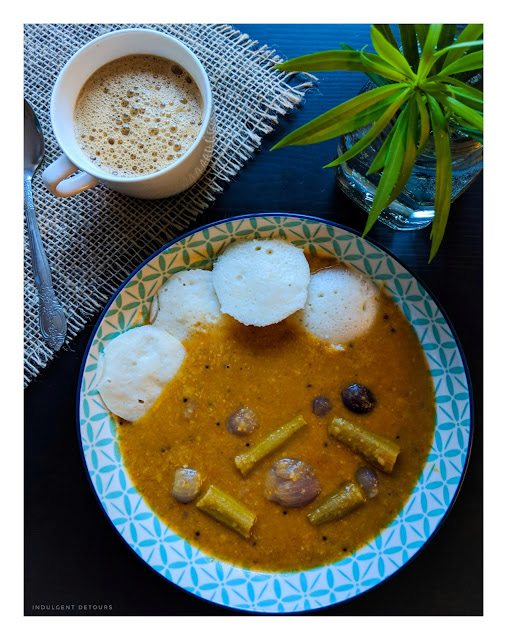Three States and a Sambhar!
My early childhood was spent in Kalpakkam - Tamilnadu, a small town on the coast of Southern (E) India, nestled amidst swaying coconut trees and shores of clear blue waters. We lived in the staff apartments just a mile away from the beach.
In front of our house was a big Moringa tree, standing tall against the tropical cyclones that hit the coast every year, despite which it would continue to flower and bear fruit every season. It was a source of great joy to me and my brother. on occasional weekends when the tree bore tender drumsticks, we would spend hours in the late morning sun, trying to dislodge a bunch of them from the tree. The joy of bringing our prized loot of drumsticks back home to show off to our parents was akin to successful fishing expeditions. My mom would then get busy making a quick sambhar out of the drumsticks and onions and frying some rice appalams (papads), while I sat cross legged on the kitchen floor, trying to make a garland out of the Moringa flowers. My father would be sitting in the hall, sipping on some filter coffee while reading the newspaper while my brother fiddled with his sports gear in his room. There was a harmony in the silence, as we all went about doing our activities. The air in the house would be thick with smokey wisps from the incense sticks swirling around the house. As it mingled with the steam emitting from the rice cooker and the boiling sambhar, the entire house was filled with its unique scent that I can vividly recall even today.
The medley of scents and the drumstick sambhar are a reflection of my unique triad background. With a Telugu ancestry, Karnataka's traditions and practices and a Tamil setting influencing our daily lives, this sambhar represents a peaceful harmony of 3 cultures, learning's and traditions. The ingredients that go into this lentil dish such as the ground coconut or the sambhar power could be very well from any of these three states and discerning it would be like tracing a single colored thread across a colorful 6 yard silk saree.
Today morning as I went about making this sambhar, while the scent of the incense sticks were of a different fragrance and the rice was replaced with Idlis, but for a moment it felt like I was back in kalpakkam, on our kitchen floor proudly showing my mom the uneven garland in my hands.
Ingredients:
1.5 cups of toor dal washed and drained
2 long drumsticks washed
A handful of small onions washed and peeled (do not chop them)
3 tablespoon shreaded fresh coconut
2 tablespoon sambhar powder ( I used homemade, but store bought works too)
A handful of tamarind washed
Water as required
1 Teaspoon oil for tempering
mustard seeds
A pinch of Asafoetida
A pinch of turmeric power
Salt to taste
Chilli powder as per taste
In a pressure cooker, add the dal and twice the amount of water and cook it for 3-4 whistles. Meanwhile, chop off the sides of the drumsticks (half an inch) and then chop the remaining drumsticks in finger length pieces. In a big deep bottomed pan, add the peeled small onions, chopped drumsticks, a pinch of salt and 1.5 cups of water. Boil the vegetables for 6-8 minutes, switch off the stove and keep aside. The vegetables should be just tender and not mushy. Also, in a mixer, grind the shredded coconut and the sambhar powder to a thick paste. You can also prepare the tamarind juice by adding warm water to the tamarind and squeezing it till pulpy. Discard the tamarind pulp and retain the juice from it.
Once the dal is cooked, add the vegetables and the water. Don't add too much of the water if it makes the sambhar too thin in consistency. Add in batches if necessary. You could save some water for the coconut mixture as well. Now boil the dal and vegetable mixture on low flame and add salt, tamarind pulp, coconut sambhar mixture and mix well. You can use the remaining water from the boiled vegetables to clean out the mixer for residual paste and add it to the dal. At this point, depending on taste, you can add chilli powder as well.
Let the entire mixture boil for 6-8 minutes on a low flame to absorb all the spices. Keep stirring it occasionally. In the end, in a small pan, temper hot oil with mustard seeds and add the hing once they start spluttering. Pour into the sambhar and serve with steamed rice or idlis like I did.
Happy Breakfast!

Comments
Post a Comment